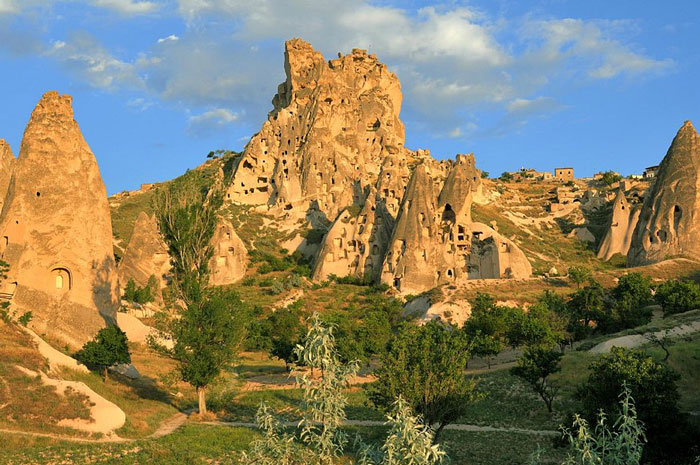Uchisar Castle
 The Uchisar Village, a little troglodyte village, is the first that visitors see when they leave Nevsehir to drive to Goreme. The village is dominated by a huge plug of rock, a so-called kale (castle) which is mirrored in Ortahisar, a similar-sized but much less visited village just off the road from Nevsehir to Urgup.
The Uchisar Village, a little troglodyte village, is the first that visitors see when they leave Nevsehir to drive to Goreme. The village is dominated by a huge plug of rock, a so-called kale (castle) which is mirrored in Ortahisar, a similar-sized but much less visited village just off the road from Nevsehir to Urgup.
Way back in history Uchisar’s was the “outer castle” and main point of the defence for Cappadocia region. Ortahisar was the “middle castle.” Bashkale, “the first “castle”, was eventually renamed Urgup.
At the first sight the exterior appearance is plain ugly, looking like a mass of rocks that were crassly carved in haste, but the construction was just keeping in line with traditions of Cappadocia throughout history and that was building homes and fortification structures out of the natural rock.
The castle does not hold any antiques, ancient portraits of royalty or any example of outstanding architecture. The stone walls and floors are bare. There is nothing in particular to look at except for the numerous hollowed-out containers, rock tombs, and a large water cistern - all welcome you as silent witnesses to history and human life.
However, the prize is the astonishing panoramic view of the landscape. Mts Erciyes and Hasan aside, Uchisar Castle is by far the most conspicuous feature of the Cappadocian landscape.
This tall volcanic-rock outcrop and the tallest fairy chimney (1.350 m above sea level) is one of Cappadocia's most prominent landmarks and visible for miles around. Riddled with tunnels, it was used for centuries by villagers as a place of refuge when enemy armies overtook the surrounding plains. Climbing through its mazy core to the panoramic vantage point of its peak is a sublime way to watch the sun set over the rock valleys of the Cappadocian countryside - everything from the fantastic hues of red on Mt. Erciyes to the Hasan Mountains, from Pigeon Valley to Avanos, from the Ortahisar castle to the town of Göreme
In the past, families hollowed caves out of the rock and used them as retreats whenever enemies appeared; in more peaceful times those same caves provided homes for the locals, so that Uchisar Castle (Kale) functioned rather like a natural tenement block stuffed full of apartments.
In the 1950s the authorities moved residents out of the castle and into modern afet evleri (disaster houses) for fear of a landslide. They were only just in time - in the 1960s a serious rock fall caused the collapse of the Ağa’nın Konağı (the Lord’s Mansion), a palatial home that had been created inside it.
The rock formations that huddle in the wake of the kale are almost equally dramatic. Most soar above the surrounding houses, their sides pockmarked with pigeon-houses, their facades daubed with patterns in red and white pigments aimed at luring the vital, manure-supplying birds to a favoured roost.
The Uchisar Fortress has been on the list of UNESCO World Heritage Sites since 1985 and been also under preservation as a National Park since 1986.
 English
English
 Türkçe
Türkçe
